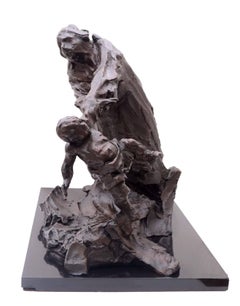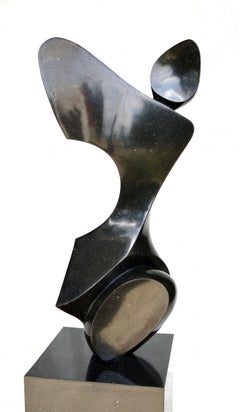Curt Beckmann Art
Curt Beckmann, sculptor and draughtsman, studied at the Kunstakademie Düsseldorf with Hubert Netzer and Richard Langner. After stays in Italy and Paris, he went to Hamburg, where he stayed until 1950 and then he returned to Düsseldorf. He was a member of the Rheinische secession in the Young Rhineland, the KünstlervereinMalkasten, the Westdeutscher Künstlerbund and the Association of German Artists. After the war, Beckmann lived for some time in a studio in Alsterdorf, where he worked in close contact with the family of a playwright Wolfgang Borchert who named the protagonist of his play The Man Outside after Beckmann. In Düsseldorf and Hamburg, he was associated with Hermann Blumenthal, Kurt Lehmann and Gerhard Marcks. Beckmann was represented in numerous public galleries including, the National Gallery in Berlin. Beckmann was married twice and had six children. His second wife was the painter Babette Beckmann from Hamburg.
1960s Abstract Impressionist Curt Beckmann Art
Granite, Bronze
20th Century Modern Curt Beckmann Art
Granite, Bronze
2010s Abstract Curt Beckmann Art
Stone, Granite
2010s Contemporary Curt Beckmann Art
Granite, Bronze
21st Century and Contemporary Abstract Expressionist Curt Beckmann Art
Marble, Bronze
20th Century Abstract Expressionist Curt Beckmann Art
Marble, Bronze
21st Century and Contemporary Abstract Expressionist Curt Beckmann Art
Marble, Bronze
21st Century and Contemporary Abstract Expressionist Curt Beckmann Art
Marble, Bronze
20th Century Abstract Expressionist Curt Beckmann Art
Marble, Bronze
21st Century and Contemporary Abstract Expressionist Curt Beckmann Art
Marble, Bronze
21st Century and Contemporary Abstract Expressionist Curt Beckmann Art
Marble, Bronze
20th Century Abstract Expressionist Curt Beckmann Art
Marble, Bronze
2010s Contemporary Curt Beckmann Art
Granite, Bronze

